For me the cinema of 1992 will always be shadowed by one all-encompassing real-life event: the rioting that took place on April 29 to May 4 in Los Angeles. Those of you who weren’t living in LA at the time may not agree with my emphasis on the riots, but the fact is they cast an indelible shadow over the year’s movies, having been explicitly referenced in several of them (including MALCOLM X and the following year’s POSSE) and overhanging the fates of several others. You’ll see the riots mentioned in a number of the thirty reviews below, which as usual focus on lesser known and/or underappreciated films.
I should add that ‘92 was also the year of Robert Rodriguez’s seminal no-budgeter EL MARIACHI (although it wasn’t commercially released until early ’93) and Quentin Tarantino’s debut film RESERVOIR DOGS. That film deserves to be included here, but it’s a bit too well known. Ditto Clint Eastwood’s UNFORGIVEN, the only Academy Award Best Picture winner of the past thirty or so years that I feel deserved its win, and TWIN PEAKS: FIRE WALK WITH ME, which nearly ended the career of its genius director yet is now such a revered cult film two that books were written about it in 2017.
Anyway…
30. LEAVING NORMAL
A movie that commercially speaking never had a chance. LEAVING NORMAL was dubbed “THELMA AND LOUISE-lite” seemingly from the day it was announced, and, even more damaging, its theatrical release occurred in the midst of the L.A. riots. It stars Christine Lahti as a fed-up waitress and Meg Tilly as an abused housewife who team up on a road trip to a house Lahti owns in Alaska, where the gals are forced to confront their own restlessness amid some breathtaking scenery (with British Columbia standing in for the Panhandle). Thus, unlike Thelma and Louise, who used their road trip as an excuse to cut loose, LEAVING NORMAL’S heroines gain a newfound self-awareness and responsibility—what a concept! The film is by no means an unqualified success, being short on plausibility (the ladies drive a Hell of a long way yet never have to refuel) and a bit too bland overall. But Lahti and Tilly are both quite endearing (and underrated) performers, and LEAVING NORMAL, despite its flaws, registers as an unusually thoughtful and intelligent chick flick—precisely the sort of movie people are always telling me I should see more of, and for once they’re right.
29. L.627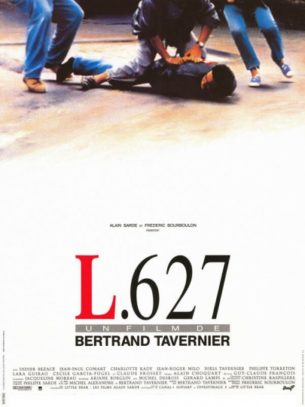
An uncharacteristically gritty drama from France’s Bertrand Tavernier about Parisian drug cops (L.627 is the French code for drug-related offences), co-scripted by a police veteran. We follow these cops’ day-to-day lives, in particular that of Lulu (Didier Bezace), a dedicated officer coming unglued because of his hooker-addict mistress (Lara Guirao). Also featured is the young and very cute Charlotte Kady (then the fiftyish Tavernier’s real-life squeeze) as a fellow vice cop who cooks extravagant meals for her co-workers in between busts. Such quirky touches are what really make L.627 work, although, like much of Tavernier’s work, it’s extremely unfocused and runs a numbing two-and-a-half hours. It also features some truly ugly sequences, in particular a downright nauseating bit where Lulu sticks his finger down the throat of a dealer who’s swallowed his stash, causing him to puke all over the ground.
28. THE NUN AND THE BANDIT
From Australia, an outback set account of a penniless bandit (Chris Haywood) looking to blackmail his wealthy uncle (Norman Kaye) who kidnaps his daughter and her keeper (Gosia Dobrowsolska), a dedicated nun. Naturally, said nun is a bit of a hottie, arousing the bandit’s baser desires. He makes a deal with her: if she submits to his advances he’ll release the girl. This may sound like conventional nunsploitation, but the execution is anything but. The writer-director was the ever-quirky Paul Cox, who couldn’t make an impersonal film if he tried. His deeply felt and totally individual filmmaking, with its measured pacing and frequent hallucinatory segues, makes for a pleasingly eccentric concoction that compels attention even when the narrative wanes.
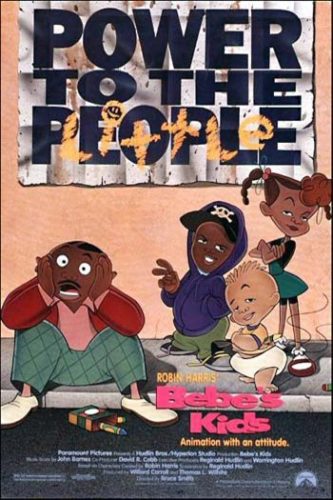 27. BEBE’S KIDS
27. BEBE’S KIDS
This cartoon comedy aimed at black audiences bombed on its original release, and has been pretty much forgotten. That’s a shame, because the film is funny. Based on monologues by the late standup comic Robin Harris, this was meant to be a live actioner, but Harris died before the project got under way and so it was reformatted as an animated feature. It has Robin (voiced by Faizon Love) forced to take “Bebe’s kids” to the Funworld amusement park because he’s after the hot chick (Vanessa Bell Calloway) who’s babysitting ‘em. These kids make the twerps from the PROBLEM CHILD flicks look like The Brady Bunch, and end up destroying Funworld while Robin repeatedly tries—and fails—to get into their guardian’s pants. Particularly good bits include Robin’s acting up at a funeral and a gut busting “Yo Mamma” session, while at the other end of the spectrum we have screenwriter Reginald Hudlin’s insistence on injecting a ham-fisted message into just about every scene (yes, I know amusement parks are shrines to empty-headed consumerism—can we please move on?).
26. ANOTHER GIRL, ANOTHER PLANET
An hour-long mood piece from writer-director Michael Almereyda shot entirely with a Fisher Price Pixelvision camera. This gives every image a cubist overlay meant, apparently, to convey the unsettled mindset of the main character; the effect is off-putting at first but grows increasingly seductive, giving the proceedings a dreamlike fascination. It features an aimless hipster (Barry Sherman) lounging around his East Village apartment together with a stoner friend and a succession of hot chicks, whose ranks include the Almereyda regulars Isabel Gillies and Elina Lowensohn. What transpires are a lot of rambling conversations, a late night freak-out by Gillies and clips from an old Max Fleischer cartoon, all set to intentionally anachronistic punk tunes. This is very nearly the quintessence of Generation X cinema, and a credible (if unacknowledged) cinematic transposition of the famous Douglas Coupland novel of that title.
25. THE PROM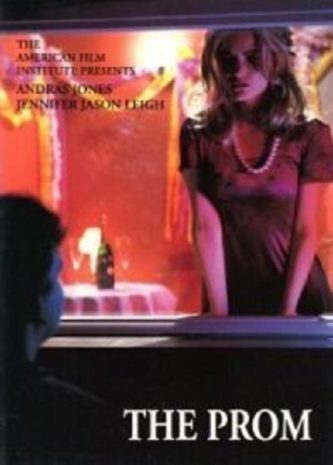
An amazingly good AFI student film. With its insightful script and slick, professional look, it’s easy to see how director Steven Shainberg (who went on to direct SECRETARY and FUR) convinced prominent actors like Jennifer Jason Leigh and J.T. Walsh to take part (it probably helped that Leigh was dating Shainberg at the time). It’s the story of a winsome young man (Andras Jones) who suffers from dark, ugly blotches that tend to appear without warning on his body. Obsessed with human oddities, he finds the only person he can truly relate to is a stripper (J.J. Leigh in a worthy addition to her repertoire of tortured lowlifes) whom he hires to be his date at an imaginary prom. Shainberg resolutely avoids commonplace sentimentality, imparting a muted anguish reminiscent of CRAZY LOVE. Having won a number of awards at various film festivals, THE PROM could conceivably have played theatrically (it’s that good), but the fifty minute running time—too long for a short film, not nearly long enough for a feature—assured it a most undeserved neglect.
24. HELL ON EARTH II: THE ARENA OF DEATH
One of the more intriguing products of the early nineties SOV horror underground was this post-apocalyptic splatterfest that is, as the title indicates, a sequel (even though the first HELL ON EARTH was an unreleased short). Over five years in the making, HELL ON EARTH II is nothing if not ambitious, running a full two hours and featuring some notably elaborate stunts. Of course, being the camcorder-shot, amateur effort that it is, one has to be forgiving of the underlit visuals, poor sound recording and uneven performances. It features future BURGLAR FROM HELL director Chip Herman as Zorak, a suave mass murderer residing in a desolate wasteland lorded over by Balrog, a mutated freak who leads an army of radiation-scarred mutants (or “meanies”). Balrog is obsessed with winning Zorak over to his side, and has him abducted; Zorak escapes Balrog’s clutches, but is telepathically ensnared by one of his psychically endowed underlings, and eventually forced to compete in the Arena of Death. All of this entails a near-continuous succession of brutal fight scenes and a great deal of lovingly depicted gore (including mass decapitations and a shot of Zorak reaching into a guy’s head and yanking out his brain). Much of the film, it must be admitted, falls flat, but there are a number of things that stand out, such as a glimpse inside Balrog’s nightmarish compound, where mutilation and cannibalism are the norm, making for what ultimately registers as a crude yet quite resonant piece of work.
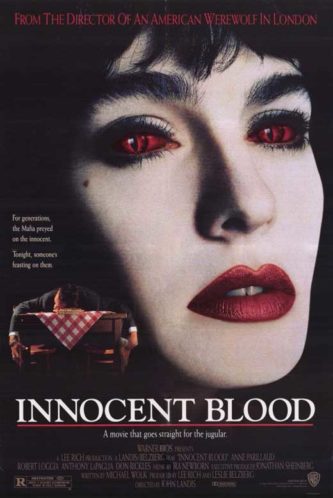 23. INNOCENT BLOOD
23. INNOCENT BLOOD
Nobody will ever mistake this vampire comedy for CITIZEN CANE, but it is a funny, gory, sexy (and extremely lightweight) treat from director John Landis, and a fitting companion-piece to his classic AN AMERICAN WEREWOLF IN LONDON. LA FEMME NIKITA’S impossibly sexy Anne Parillaud headlines as a bloodsucking babe, and Anthony LaPaglia co-stars as an undercover cop tracking a mobster played by Robert Loggia. Parillaud, in the mood for some Italian food, also has her eyes on Loggia, leading to a myriad of blood-soaked hijinks. Landis directs with clarity and energy, and includes knowing winks to a myriad of past horrors (this film has more shots of TV sets playing old horror movies than any other I’ve seen). He also pulls off some startlingly gory bits and a surprisingly potent sex scene.
22. BARJO (CONFESSIONS D’UN BARJO)
France’s Jerome Boivin (BAXTER) adapts Philip K. Dick’s CONFESSIONS OF A CRAP ARTIST in a bright, funny and decidedly twisted film. The title character, well played by Hippolyte Giradot, is a nut who spends his days collecting odd artifacts and writing his memoirs in anticipation of the end of the world, which is apparently nigh. When Barjo’s house burns down he moves into the swank country home of his high-strung sister Fanfan (Anne Brochet) and her aluminum magnate hubbie Charles (Richard Bohringer). The latter is nearly insane from Fanfan’s obsessive behavior, and is pushed over the edge entirely when Barjo moves in. In short order Fanfan grows obsessed with an attractive young couple and Charles has a heart attack; while he recovers Fanfan commences an affair with the male half of the young couple (Renaud Danner) and Barjo falls under the spell of a creepy psychic woman (Consuelo De Havilland). It all turns out as you might expect (i.e. darkly), although there is a happy ending of sorts involving a ghostly visitation that, given the eccentric and surreal bent of the film overall, actually works quite well.
21. THE NORTHERNERS (DE NOORDERLINGEN)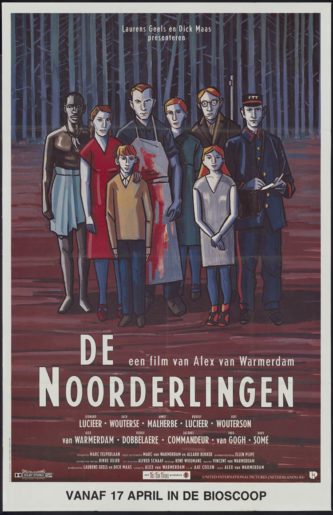
This darkly comedic soap opera appears to be Holland’s answer to TWIN PEAKS. It’s chock-full of quirky—and often downright revolting—characters, all living in a small town situated between a desert and a forest. Said forest is the setting for all sorts of bizarre events, such as the town mailman building fires therein to steam open letters, a man using the area to hide out after escaping from a traveling missionary exhibition, and a nymphomaniac who seduces nearly every guy in the town–and pays an extremely high price for it. The film is as weird, outrageous and defiantly original as just about anything I’ve seen, yet with a disarmingly quiet, subdued style. Not all of it works, but director Alex Van Warmerdam’s assured filmmaking and twisted imagination make for an unforgettable, one-of-a-kind experience.
20. WATERLAND
A good try. This movie, adapted from A.S. Byatt’s highly literary 1983 novel, stars Jeremy Irons as a British teacher attempting to get through to some bored American high schoolers—Ethan Hawke and a debuting Maggie Gyllenhaal among them—while contending with unsettled childhood memories. The film flashes back and forth between those memories, involving Lena Headey as a flighty young woman whose grown-up incarnation (Sinead Cusack) is married to Irons, and the present, often deliberately mixing the two time periods together, with Irons’ students interacting with the world of 1950s-era Britain. Sounds like prime Nicolas Roeg material, and Roeg could indeed have made something quite special out of this, but director Stephen Gyllenhaal (of PARIS TROUT and the siring of Jake and Maggie) isn’t quite up to the challenge. He has at least succeeded in creating an extremely good looking, richly atmospheric piece of work that plays like a cross between WILD STRAWBERRIES and DAYS OF HEAVEN.
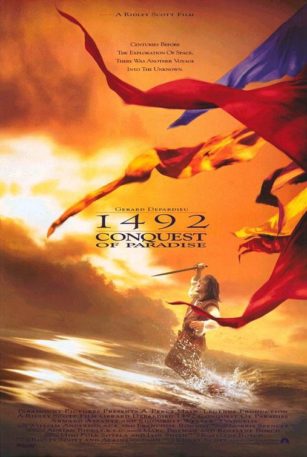 19. 1492: CONQUEST OF PARADISE
19. 1492: CONQUEST OF PARADISE
This pricey Christopher Columbus biopic was one of the decade’s biggest flops, but I say it deserves a reappraisal. The film, like so many of those of its director Ridley Scott, really needs to be experienced on a big screen to be fully appreciated, something far too few viewers bothered to do (luckily I was working as a projectionist during 1492’s brief theatrical run, and so was afforded quite an eye-full). Admittedly, the film has a number of flaws, including a cobbled-together script, a so-so Vangelis score and a cartoony bad guy character (perennial 90’s heavy Michael Wincott) who’s tasked with taking on the real-life Columbus’s bad qualities. But from a purely visual standpoint the film is a masterpiece, being very likely the best-looking Ridley Scott movie since BLADE RUNNER, while in the title role Gerard Depardieu cuts quite a striking and magisterial figure (and a good thing, as most of his line readings are unintelligible).
18. THE WATER ENGINE
A little-known made for cable television film that, unexpectedly enough, emerges as one of the finest David Mamet adaptations to date. Director Steven Schachter never quite overcomes the painfully low budget with which he was saddled, but does succeed in rendering Mamet’s patently stage-bound story in crisp and cinematic fashion. The basis is a popular urban myth about a man who in the early Twentieth Century invented an engine that ran on water, only to have his efforts squashed by greedy business tycoons. William H. Macey plays the man in question, a resourceful but quite prickly fellow who upon attempting to patent his engine sets off a calamitous chain of events that, as in all Mamet’s best work, can be viewed in at least two different ways. This is to say that the film can be taken as either a straightforward portrayal of institutionalized corruption stripping the revered “little guy” of his rightful earnings or as a pitiless study of a severely flawed individual destroyed by his own intransigence. Either way it’s a highly provocative piece of work, enlivened by Mamet’s superbly rhythmic dialogue, spoken by a cast comprised of quite a few of his stock players—of whom Macy and a superbly slimy Joe Mantegna are the undoubted standouts.
17. DEAD BOYZ CANT FLY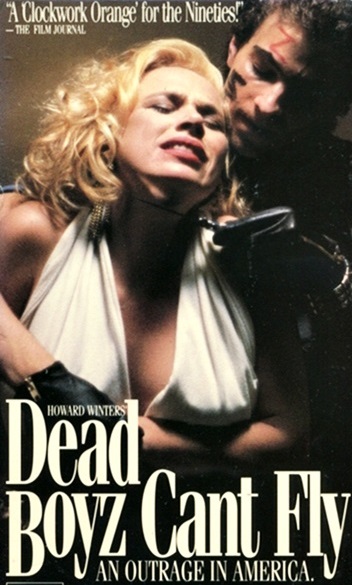
An absolute must-see for trash movie mavens: a wild, irresponsible, unabashedly over-the-top brutality fest. It’s about three maniacs loose in a high rise, where they torture a dentist with his own equipment, give a doctor’s patient an unwanted gynecological exam, repeatedly slam a dude’s head in a file cabinet, hang a suicidal office drudge from the rafters, try to jump-start a gang banger’s stopped heart with live wires, etc., etc., etc. The lackluster first twenty minutes are somewhat off-putting, but stay with it, as director Howard Winters (actually the veteran sleaze-meister Cecil Howard) really hits his stride once the nastiness starts up. The script is consistently imaginative and unpredictable, even if it does falter in some spots; an intrusive detective duo is plain superfluous (and played by two of the worst actors you’ll ever see), as is the poorly staged graveyard-set finale (especially since the preceding scene, with its unforgettable screaming mouth close-up, closes things out in a far more satisfying manner).
16. LA CONTROVERSE DE VALLADOLID
A made-for-French-TV movie that dramatizes the sixteenth century debate about the use of Native Americans for slave labor, and whether those natives possessed souls. This debate takes the form of an inquest held in a church at Valladolid, the (then) capitol of Spain, where a compassionate friar (Jean-Pierre Marielle) argues that the natives are as soulful as any European; he’s opposed by a slick philosopher (Jean-Louis Trintignant) who asserts that the natives shouldn’t be counted as human. Obviously we know which point of view eventually wins out, but the brilliance of LA CONTROVERSE DE VALLADOLID is how it draws us into this debate with grace, style and a great deal of suspense. Nearly the entire film takes place within the confines of the church, yet it’s quite lively and features many interesting developments, including a large totem dragged into the church and, in a genuinely startling bit, a Native American baby threatened with death in an effort at ascertaining the emotional barometer of the kid’s parents.
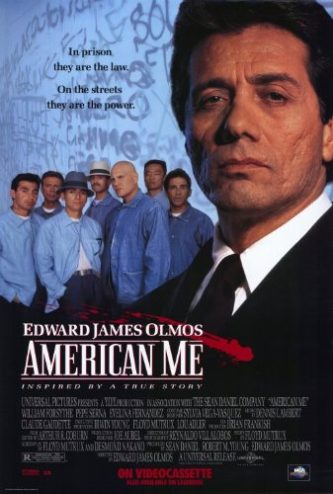 15. AMERICAN ME
15. AMERICAN ME
Probably the finest nineties mob movie after GOODFELLAS, this is a stark and unforgiving depiction of the La Primera (Mexican mafia) scene at the time of the L.A. riots. It was the directorial debut of Edward James Olmos, who was apparently threatened and extorted by actual Chicano gangbangers because of this film—which I’d say is proof of its power. Olmos plays a small time thief in East LA who rises to power while in prison. The prison scenes, which take up much of AMERICA ME’S first hour, are among the most brutal and realistic I’ve seen in any movie, giving us an up close and uncomfortably personal look at underworld economics and their life-and-death implications. It’s that clear-eyed sense of how real criminals operate that lifts this film above most other nineties mob flicks, and also the complete absence of any sort of romanticism. It does admittedly get a bit preachy in the final half hour, in which Olmos starts to question his criminal proclivities after being lectured by his girlfriend (Evalina Fernandez), but the ending is as shocking and relentless as can be imagined. FYI, the DVD features an above average making-of documentary, showing how the film was put together with actual gangbangers in the cast, many of whom were moved to reform their ways in later years.
14. MIDORI (SHOJO TSUBAKI: CHIKA GENTO GEKIGA)
Adults-only anime madness that’s stylish, outrageous and disturbing, and undoubtedly the ultimate movie (after FREAKS) about a traveling freak show. Inspired by the infamous manga MR. ARASHI’S AMAZING FREAK SHOW by the ero-guro maestro Suehiro Maruo, MIDORI was a five year labor of love by director Hiroshi Harada, who personally animated the film himself (and reportedly used his life savings to do so). It features the doe-eyed Midori, who joins a traveling carnival populated by human oddities that abuse and degrade her unmercifully—at least until a strange dwarf joins the carnival and romances Midori, with results that are ultimately catastrophic. Not merely faithful to its source material, MIDORI actually takes its imagery directly from the manga, with visuals that consist largely of still pictures animated with minimal movement and voice-over dialogue. The effect is not unlike the “motion comic” adaptations of WATCHMEN and THE DREAM-QUEST OF UNKNOWN KADATH, although Hiroshi Harada adds many arrestingly quirky touches. Nor does Harada shy away from Maruo’s excesses, replicating the manga’s bloodletting and perversion without apology or restraint.
13. LORENZO’S OIL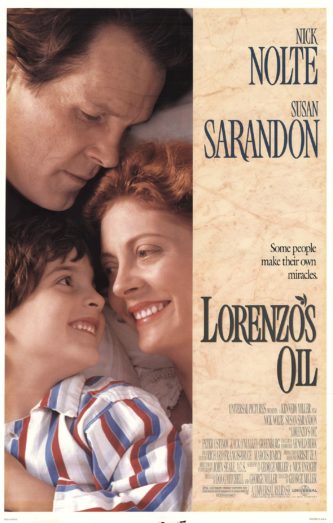
A tough film, and still one of the best things director George Miller has ever done. Thoroughly compelling from start to finish, it’s a dramatization of the real-life ordeal of Lorenzo Odone (played principally by Zack O’Malley Greenburg), a young boy diagnosed with a degenerative brain disease. Nick Nolte plays Lorenzo’s father (with a less-than-convincing Italian accent) and Susan Sarandon his mother, who becomes determined against all odds to find a cure; this entails methods and behavior that are scientifically questionable, and result in a lot of horrific pain for her son. The ending, you can rest assured, is a happy one, although the possibility is broached that Lorenzo’s mother might have been better off simply letting him die. Miller, a trained M.D., relates this science based account in fast-moving, near montage fashion, turning material that could have been stultifying into a kinetic spectacle on par with the MAD MAX films that are Miller’s specialty. Unlike those films LORENZO’S OIL wasn’t much of a success, due most likely to the fact that it’s so painful to watch.
12. LESSONS OF DARKNESS
Werner Herzog has never been one to shy away from the unusual or extreme, and in this impressionistic 50 minute montage he documents the closest thing to a literal Hell on Earth: Kuwait in the months following the first Gulf War. We see lakes of bubbling oil and other-worldly landscapes dotted by burned out vegetation, along with a ground zero look at the many out-of-control fires emitting pitch black smoke that blots out the sun and rains down streams of ash, while firefighters try valiantly to get it all under control. A slight but brilliantly visualized, deeply affecting work. I can’t imagine any special effect coming close to capturing the Biblical sheen of the apocalyptic imagery on display here.
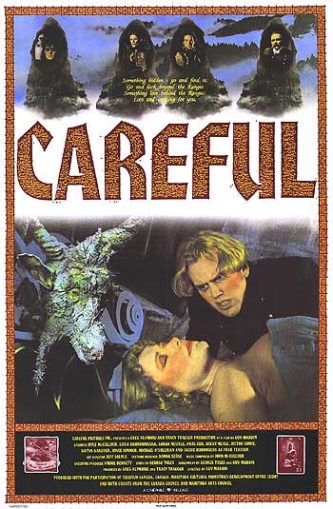 11.CAREFUL
11.CAREFUL
This was the ever-eccentric Guy Maddin’s first color film. Like all his films, it’s an utterly distinctive work that revels in artifice, from the gorgeously tacky color scheme (only two colors per scene, usually bleached-out shades of yellow and green) to the intentionally scratchy soundtrack. Maddin deliberately conjures up German mountain dramas from the thirties, but adds his own baffling sensibilities to this warped tale of an Alpine village whose inhabitants must be careful at all times. Avalanches, you see, are a constant threat, so everyone needs be very quiet–a dictum that extends to corpses, whose hearts are punctured prior to burial on the off chance that they might come back to life. Understandably, the townspeople harbor a shitload of repressed urges, which give way after a young man has an incestuous dream about his mother. Quite simply, nobody else but Maddin could have made this film. His work is an acquired taste, to be sure, but once you’ve made the proper mental adjustment you may just find yourself as hooked on it as I am.
10. WICKED CITY (YAO SHOU DU SHI)
The incomparable Tsui Hark executive produced and co-scripted (and, I’m told, partially directed) this Hong Kong live action remake of the popular 1987 anime WICKED CITY, adapted from the Hideyuki Kikuchi novel of the same name. The premise: our world co-exists side-by-side with another, inhabited by bug-like monsters who periodically turn up here to quench their appetite for human flesh, for which reason special BLADE RUNNER-esque police forces have been set up to hunt ‘em down. The anime announced its intentions in the first few minutes, with a woman’s vagina sprouting teeth. This version (mostly) forgoes the misogyny in favor of a testosterone-drenched shoot-‘em-up, spiced with a wealth of prosthetic effects. Thankfully, it keeps the emphasis on the action, which is frantic and excessive even by HK standards, and not a little incoherent. Coherency, however, isn’t something I value terribly in my Hong Kong cult flicks, whose virtues WICKED CITY displays quite boldly—which is to say that when it ended I definitely wasn’t left wanting more.
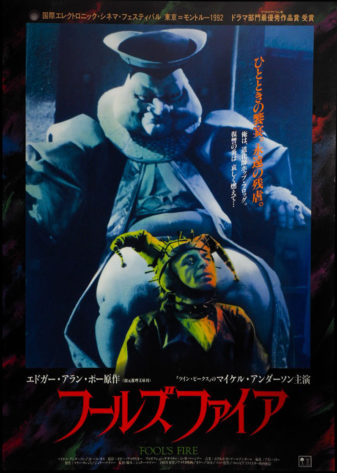 9. FOOL’S FIRE
9. FOOL’S FIRE
From Julie Taymor, a weird and wonderful 55-minute American Playhouse production of the Edgar Allan Poe tale “Hop Frog.” The story is a brief and nasty account of the eponymous dwarf jester enacting a grotesque revenge on his corrupt superiors at a costumed ball. TWIN PEAKS’ Michael Anderson plays Hop Frog, the only human character in a landscape populated by giant, leering puppets. He meets Trippetta (Mireille Mosse), a fellow dwarf kept locked in a cage, and it’s love at first sight–but when she’s tormented by the corrupt King and his minions, Hop Frog goes over the edge. The costume and set design, both designed by Taymor herself, are eye popping and endlessly imaginative. The film is set in a deliberately artificial miniature kingdom situated on a spinning globe, with the guests of the costume Ball depicted as artist’s mannequins. Also featured is a plethora of Lynchian dream imagery and a banquet scene lifted from Rabelais’ GARGANTUA AND PANTAGRUEL, in a distillation of Taymor’s obsessions that’s more potent than any of her feature films.
8. TRESPASS
One of the most memorable products of the LA riots, a gratuitously violent, politically incorrect actioner about blacks versus whites in an abandoned slum. The location is ostensibly St. Louis, but the images of desperate folks shooting and scavenging in a ravaged ghetto landscape (the original title was LOOTERS) will seem all-too familiar to anyone who lived in LA at the time. Director Walter Hill has delivered one of his most energetic, visually unforgettable productions, but I’d argue that the film’s real spark is the screenplay by Robert Zemeckis and Bob Gale, a warped variant on THE TREASURE OF THE SIERRA MADRE that recalls the Zemeckis/Gale scripts for I WANNA HOLD YOUR HAND and USED CARS in the way it takes a more-or-less simple premise and runs riot (pun intended). It features a pair of firemen (Bill Paxton and William Sadler) infiltrating an abandoned housing project in search of buried treasure at the same time a gang (led by Ice T and Ice Cube) is executing one of its enemies in the same location. The ensuing action includes a staged police beating and an intrusive video camera (more shades of early nineties LA), a kidnapping, lotsa firepower and a mind boggling array of double crosses.
7. WIND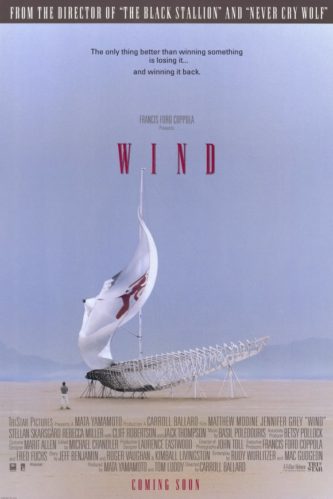
A most unlikely yacht racing drama from director Carroll Ballard and co-screenwriter Rudy Wurlitzer, neither of whom are known for sports movies. This explains WIND’S highly quirky, character-based overlay, which irritated mainstream viewers but pleased me greatly. Matthew Modine stars as a rich twerp who wants to win the America’s Cup back from the Australians, and Jennifer Grey plays his ex-girlfriend, who’s married one of Modine’s teammates (Stellan Skarsgård). Taking place in a succession of scenic exteriors, the film is a visual stunner with a rousing Pasil Polidouris score and a grindingly intense final race, proving that even with subpar material Ballard is one of the most capable directors in the business.
6. THE CHEKIST (CHEKIST)
A truly shocking, traumatizing film, and quite probably the most blatantly anti-communist feature ever made in Russia. The setting is 1917, at the birth of the Russian Revolution, in which we follow the day-to-day life of a “Cheka” (Bolshevik secret police) officer whose job it is to judge and assassinate anyone who doesn’t accept the new regime. This guy (Igor Sergeev) and his equally sociopathic co-workers haul their victims into a dimly-lit basement room, then strip and shoot them in the backs of their heads. What begins as a political rant punctuated by a few graphic executions quickly turns into an unrelenting gore fest that even I found distasteful; equally disturbing is the officers’ nonchalant, matter-of-fact attitude toward their actions. A stunningly powerful bit of reality-based devastation, but (do I really need to say it?) most definitely not for the squeamish.
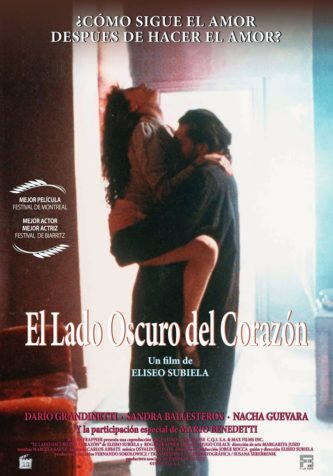 5. THE DARK SIDE OF THE HEART (EL LADO OSCURO DEL CORAZON)
5. THE DARK SIDE OF THE HEART (EL LADO OSCURO DEL CORAZON)
Although I can’t quite bring myself to give this Argentinean outrage an unqualified recommendation, I do have a soft spot for it. It contains, after all, three things I really like in my movies, namely sex, poetry and surrealism. Inspired by the writings of the late Oliverio Girondo, it’s the story of a poet (Dario Grandinetti) looking for love (or at least a really good lay). He’s very particular in his quest, laying out his requirements in an oft-repeated monologue proclaiming that under no circumstances will he accept a lover who “can’t fly.” Those bedmates who don’t make the grade get ejected into a void Grandinetti opens by pushing a button on his bed stand. He eventually finds a gal who can indeed fly, a flighty prostitute (Sandra Ballesteros) who continually rejects his advances, which include ripping his still-beating heart from his chest and offering it to her on a plate–along with a hundred dollar bill! He also crawls up the gal’s vagina at one point, chats with a woman who dresses in black and is in fact the angel of death, gets berated by his dead mother whose voice emanates from the mouth of a cow, and hangs out with a buddy who lives in an apartment accessible via a giant walk-in vagina. All this fun stuff is offset somewhat by the unevenness of the enterprise, which is wildly episodic and packed with lengthy political diatribes comprehensible only to longtime residents of Argentina. The film, I should add, was a sizeable success therein, and inspired a 2001 sequel I haven’t seen.
4. FORTRESS
Essentially the cinematic equivalent of a double cheeseburger and fries. Films like FORTRESS are the reason I sit through so many crappy “cult” films, as very once in a while I stumble onto something so wild, so thrilling, so unpretentiously entertaining that it’s impossible not to get swept along. Set in an outrageous futuristic prison, the movie stars Christopher Lambert as an unjustly incarcerated ex-military man looking to escape with his life, and sanity, intact. There’s a cliffhanger every five minutes or so, and director Stuart Gordon, of RE-ANIMATOR fame, keeps the violence plentiful while contributing some surprisingly stylish visuals. That’s not to say this low budget production ever forgets its place, as it’s a B movie through and through and makes no apologies for it.
3. BITTER MOON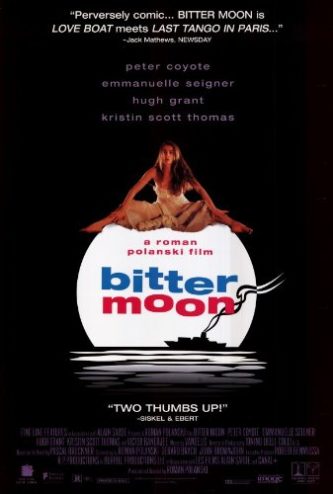
I strongly believe that in time this almost universally misunderstood film will at last achieve the recognition that has thus far eluded it. It’s a wild and crazy black comedy about sex that in the hands of Roman Polanski becomes a grotesquely satiric exploration of thwarted desire. There’s clearly more than a little autobiographical resonance herein, as Emmanuelle Seigner, Polanski’s wife, plays the designated siren. Her relationship with asshole novelist Peter Coyote strikes me as a little too realistic for comfort, as their initial sexual bliss quickly fades into apathy and eventually outright hatred, during which they develop a “narcotic dependence on television.” In a parallel plot thread stuffy Englishman Hugh Grant attempts to initiate a peccadillo with Seigner aboard a cruise ship, but finds he’s hopelessly out of his league. And that’s just the beginning of an odyssey that touches on jealousy, revenge, rage, lust, impotence and out-and-out psychosis in an at times shocking and always surprising pic that kept me riveted throughout its 139 minute runtime.
2. GOD IS MY WITNESS (KHUDA GAWAH)
For quite a few of us Westerners this film, released on VHS in the late nineties by Scarecrow Video, was our introduction to the joys of Bollywood. Functioning as both a PULP FICTION-esque riff on Bollywood action movie conventions and a joyous wallow in them, GOD IS MY WITNESS is one of the few films I can honestly say has everything: large scale musical numbers, Hong Kong-style gunplay, an overheated love story, friendship, passion, betrayal, revenge, loyalty, madness and Amitabh Bachchan and the late Sridevi, two of the biggest stars in the Bolly-verse. It involves a beautiful woman (Sridevi) bent on revenge and an absurdly virtuous man (Bachchan) in love with her, a dynamic that sets off a chain of events I really can’t summarize without writing a novel, but I can assert that the three hour-plus runtime passes in a breeze. The overwrought performances are all of a piece, and fit the action like a glove, while the pacing (in a word: fast) is spot-on perfect.
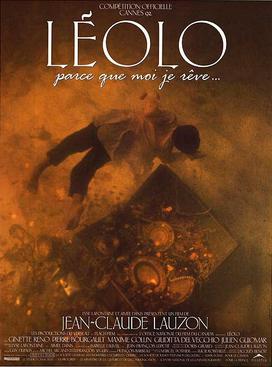 1. LEOLO
1. LEOLO
This French-Canadian production looks at the bizarre childhood of one Leo Lenore (Maxime Collin), a precocious tot who renames himself Leolo Lozone after his love of all things Italian. This love extends to a Sicilian girl (Giuditta Del Vecchio) who lives next door to his wacky family’s depressed townhouse—and one look at that family tells you all you need to know about why this kid has such a varied fantasy life. His parents are obsessed with bowel movements to the point of checking the crapper every time Leolo gets off it and he’s got a number of crazy siblings interned in a nuthouse. All this was apparently semi-autobiographical on the part of the film’s writer-director, the late Jean-Claude Lauzon, who after putting out 1987’s blah NIGHT ZOO unveiled a sensibility as distinctive as that of Fellini or Tarkovsky. The characters are all so wonderfully delineated that I now see them as actual people rather than roles in a photoplay, in particular Leolo’s brother Fernand (Yves Montmarquette), a skinny wimp who can’t hide his cowardly nature even after he becomes a bodybuilding muscle head. LEOLO is one of the finest films of the nineties, and certainly one of the finest Canadian films of all time, by turns touching, hilarious and grotesque (a scene involving a bunch of degenerate kids and a cat may well be the most offensive thing I’ve ever seen), a perfectly realized, defiantly individual creation.
